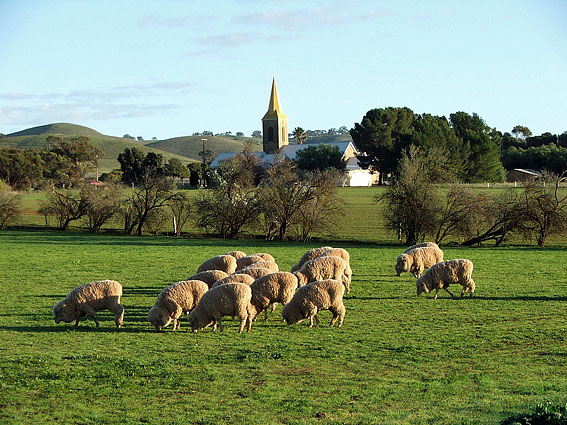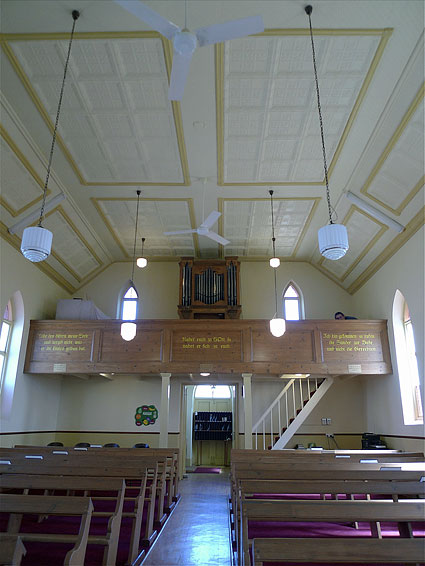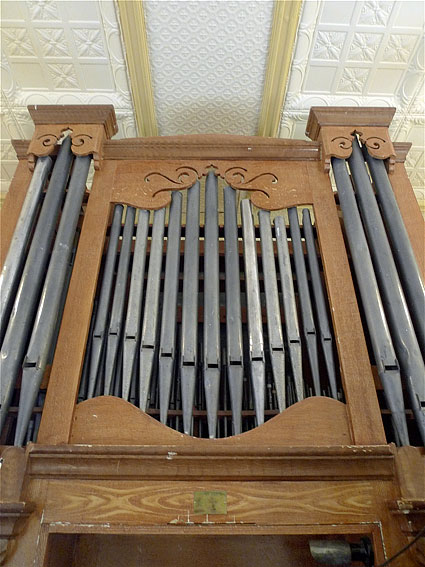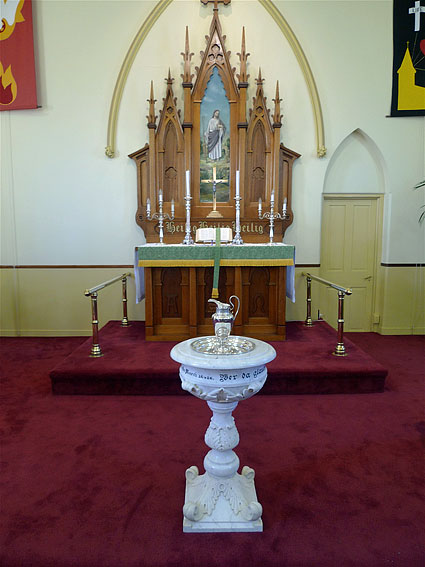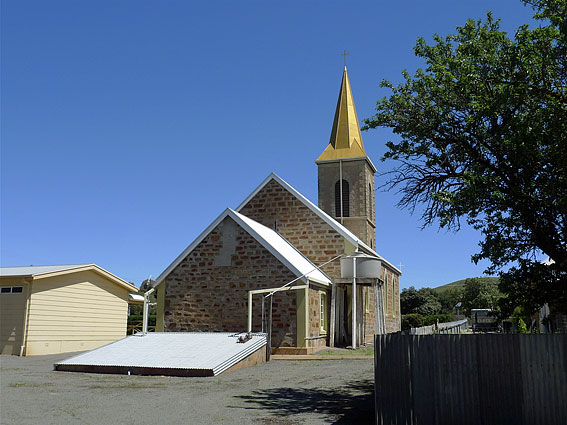Immanuel Lutheran Church
Eudunda Road, Point Pass
B 1876 D.H. Lemke.
1m, 4spst, no pedals, tr. Man: 8.8.4.2.
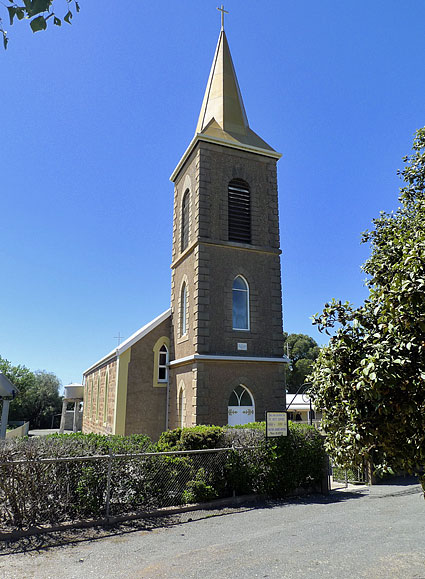
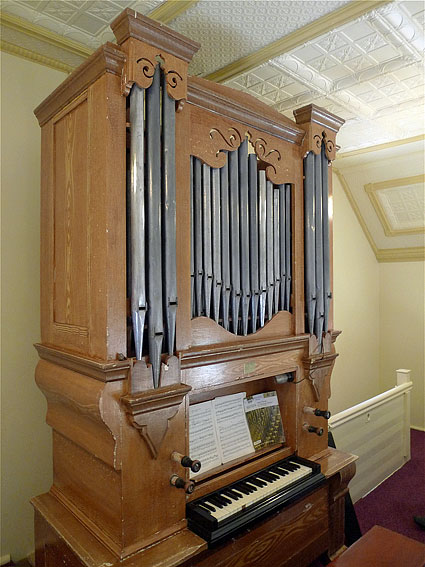
Immanuel Lutheran Church
Eudunda Road, Point Pass
B 1876 D.H. Lemke.
1m, 4spst, no pedals, tr. Man: 8.8.4.2.


From the 2009 OHTA Conference Book, David Shield writes:
Both
Lutheran Churches at Point Pass had pipe organs. The first Lutheran church, Immanuel, established in the
district in 1871, obtained an instrument from Daniel Lemke which it retains. St Peter’s Lutheran, created as a
result of schism, also acquired a pipe organ, the provenance of which is
incomplete. It appears to have
been made by Walter Rendall for an Adelaide music teacher and is now to be
found in the Lutheran church of St Michael at Marananga. In 1960, the two parishes amalgamated.1
The
first German settlers came from Light Pass in 1868. Pastors Rechner and Appelt conducted services in the homes
of members alternately about every six weeks until the first church, Immanuel,
was built and dedicated, on Ascension Day 1871. At this point, Pastor Appelt’s followers withdrew and built
their own church at Emmaus. A
second building was dedicated on 9 April 1876 with tower, spire, and bell being
added in 1913. The Lemke organ was
placed into the new church at the time of dedication. Pastor Stolz was installed as the first resident pastor.2
IMMANUEL
LUTHERAN CHURCH, POINT PASS
As with each of the Lemke instruments, this
single-manual short compass organ has four ranks of pipes with pitch
designations only given on the stop labels. Again, only the two wooden ranks were made by Lemke. Stiller found the metal ranks to be odd
secondhand pipes bearing various inscriptions such as “Har” “Gam” “15” “Pr” and
“Op”, which allows for some conjecture as to their origin.3 Situated in the west end gallery, the
organ’s provenance is determined by the existence of a paper label on the c0
pipe of the 8 Gedact of larger scale.
The inscription reads “D.H. Lemke Moculta April 9th
1876.” This allows the question to
be asked as to whether Lemke originally repeated this practice on the other
organs he constructed but with the passage of time they have disappeared. Foot blown by treadles, an electric
motor to supply the winding was also added in 1975. Apparently the organ was dismantled during World War II by
the Revd H.F.W. Proeve and placed into storage.4
Daniel
Lemke 1876
1
manual, 4 speaking stops, no pedals, mechanical action
MANUAL
8 [Gedact of larger scale]
8 [Gedact of smaller scale]
4 [Principal]
2 [Octave]
Compass 49 notes C-c
Pitch designations only on stop labels
Foot and electric blown
ST PETER’S
LUTHERAN CHURCH, POINT PASS
The schism in the Lutheran Church of 1884 resulted
in a further division of the congregation and St Peter’s congregation was
established in the Point Pass township.
Pastor Reusch, of Tanunda, ministered to the congregation from Tanunda
with services initially in the Lutheran Day school. The church of St Peter was dedicated on 6 December
1885. A manse was built in 1887,
with an addition in 1910.5
Little is known about the organ in this
church. Early minute books appear
to be lost though it is known that J.T. Mickel used his own organ for the
services previous to the opening of the church. He was also responsible with Gehling for purchasing the
first pipe organ for £75 on behalf of the congregation, though further
information is needed to determine its provenance.6
The organ obviously had its difficulties. Geyer was contacted for repairs costing
£10/15/- in 1900. By the fifth
Sunday after Epiphany 1909, in a delightful turn of phrase, the organ
“renounced its services”. The
congregation decided to purchase a new American organ and consequently put down
a deposit of £25 trusting they could find the balance.7
However, a postcard throws some doubt as to the
dates of the narrative. In August
1905, J.E. Dodd briefly replied to an enquiry from a Mr G.A. Keller who gave
the post office at Nurioopta [sic] as his address. Dodd acknowledged the receipt of the post card of 12 July
and said, “I do not make a practice of buying old pipe organs, but if you will
fill in the accompanying form, I shall let you have a definite answer as to the
possibilities of my placing it for you.”
There follows a list requesting the details of the organ with a final
comment “Is it the organ lately owned by the Lutheran Church Point Pass”.8 This implies that (a) Dodd knew that
the organ was either sold, or ready to be sold, by the church, and (b) Keller
was in possession of the authority to sell the organ if the instrument was not
in his possession. A third
implication is that the history of the church record is being questioned.
Exactly what transpired is unknown. Presumably Geyer restored the organ
before its placement in the Marananga church in 1915.9
_________________________________________________________________________
1 Immanuel Church Point Pass: Friends of
Lutheran Archives brochure, n.d..
No details of the bell.
2 Hebart Th., The United Evangelical Lutheran Church in
Australia, (1938, 1985), p.270; a cemetery at the junction
of Emmaus Road and the Robertstown Eudunda Road appears to be all that is left
of the congregation worshipping at Emmaus.
3 See the discussion raised under the section for the organ at
Ebenezer
4 Stiller, J. Documentation Immanuel Lutheran Church Point
Pass Organ 21 December 1978, 21 December 1979.
5 Hebart Th., op.cit., p.272
6 St Petri Point Pass Souvenir 1885-1935, p.18
7 Lutheran Archives, Adelaide, Minutes of the Point Pass
Congregation, pp.4-5, 16
8 J.E. Dodd to Mr G.A. Keller 8 August 190,5: DLB 1903-1909, pp.375-376
9 For a further discussion of this organ, see section on St
Michael’s Lutheran Church, Marananga
